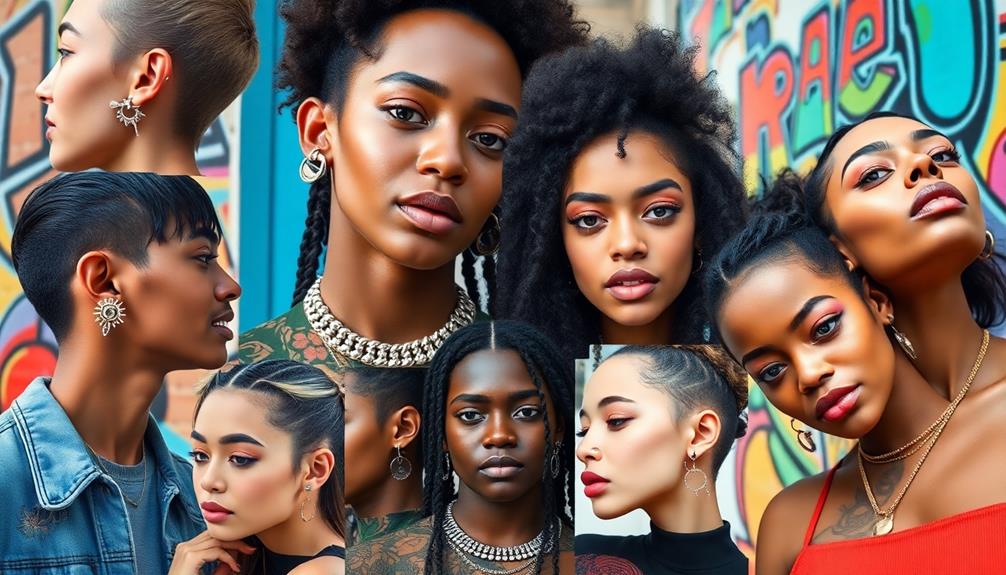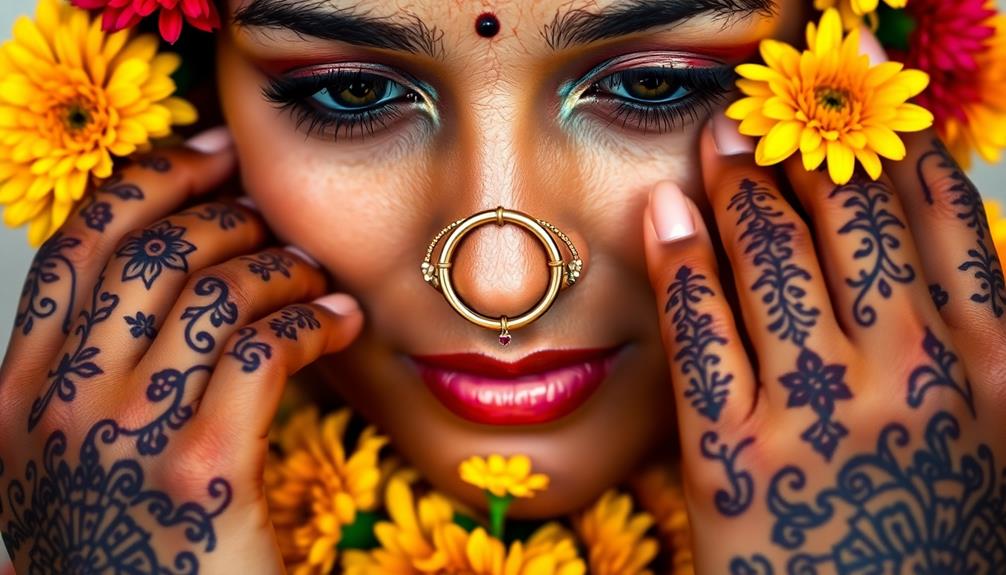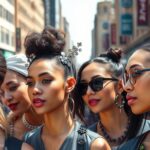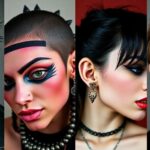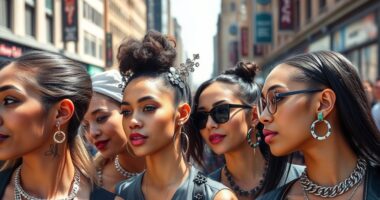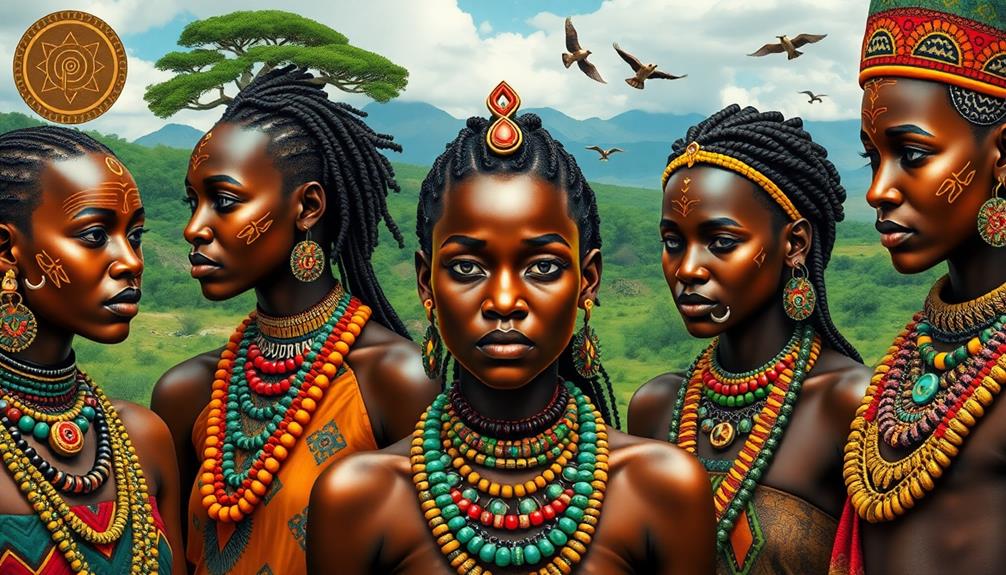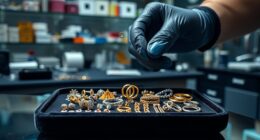Body piercings became mainstream in Western culture through a fascinating blend of history and influence. Starting as ancient cultural practices, they evolved considerably by the 1990s, fueled by pop icons like Britney Spears. Ear piercings, once exclusive symbols of status, turned into a popular rite of passage for many children. The normalization of professional piercing studios encouraged safety and acceptance. Over time, perceptions shifted from rebellion to fashion statements, embraced by the fashion industry and social media influencers. Discover how these trends shaped today's piercing culture and what they mean for self-expression.
Key Takeaways
- Body piercings have historical roots in ancient cultures, symbolizing status and identity for over 25,000 years.
- Post-World War II, ear piercings became a mainstream trend and popular form of self-expression, especially in the 1990s.
- Pop icons and celebrities, such as Britney Spears and Travis Barker, significantly influenced the popularity of various body piercings.
- The fashion industry embraced piercings as stylish expressions, integrating them into designer collections and runway shows.
- Piercings transitioned from symbols of rebellion to accepted fashion statements, with workplaces increasingly accepting visible piercings.
Historical Roots of Body Piercings
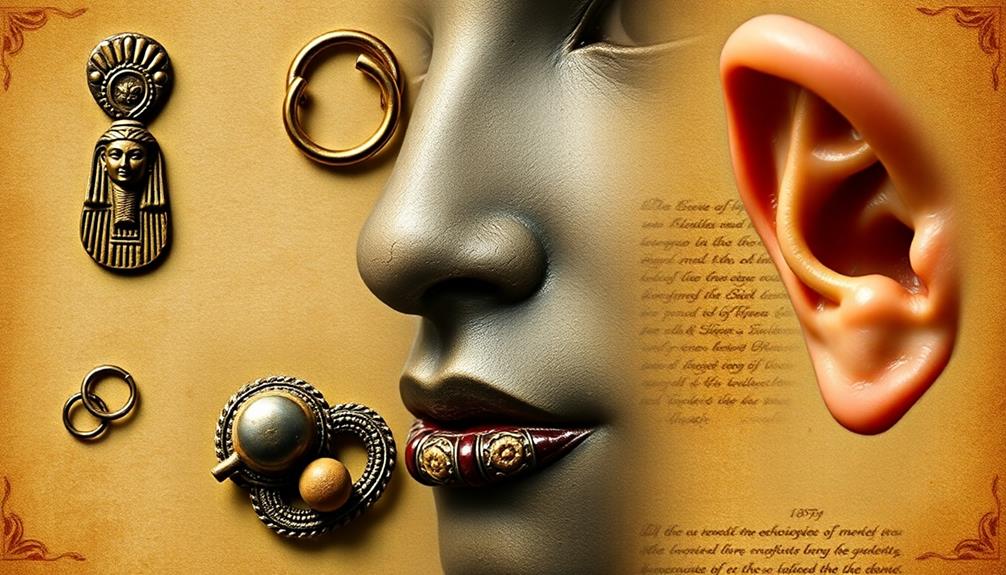
Body piercings have an ancient legacy that stretches back over 25,000 years, revealing a rich tapestry of cultural significance. This practice of body modification isn't just a modern trend; it has deep historical roots. From the Egyptians to the Romans, ancient civilizations adorned themselves with various types of jewelry, showcasing their status and beliefs. The oldest known pierced body, discovered in an Austrian glacier, dates back over 5,000 years, illustrating the enduring nature of this tradition.
In ancient Rome, soldiers wore nipple piercings as symbols of bravery and military rank, while ear piercings were favored by the elite. Similarly, Mesoamerican cultures embraced traditional piercing, using jade and organic materials to craft intricate jewelry. For them, practices like lip stretching represented beauty and social status, often serving as a rite of passage into adulthood.
However, during the colonial era, perceptions shifted dramatically. Body piercings became stigmatized, viewed as pagan by Christians, leading to societal rejection.
Yet, this rebellious aspect of body piercings later resonated with countercultural movements in the 20th century, reigniting interest in their historical significance and cultural roots.
Cultural Practices Across Societies
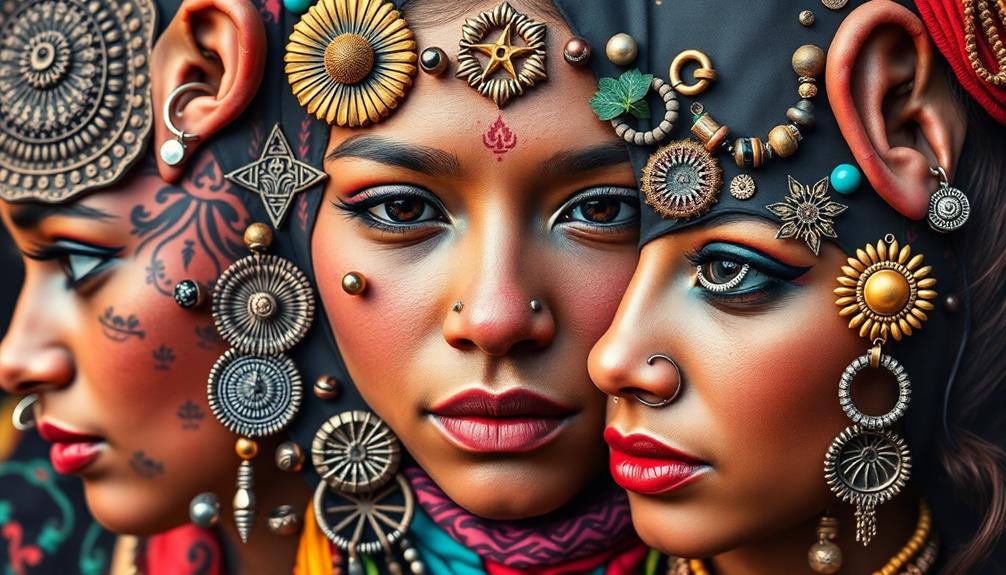
Throughout history, various societies have embraced body piercings as a significant aspect of their cultural identity. In ancient Egypt and India, ear and nose piercings date back over 5,000 years, showcasing their importance in cultural practices.
Mesoamerican women adorned themselves with lip piercings and labrets, enhancing their beauty and signifying social status. The Maasai tribe in East Africa highlights the significance of ear stretching as a rite of passage, marking the transformation from childhood to adulthood.
In ancient Rome, piercings held military significance, where soldiers donned nipple rings to represent bravery and rank. This practice illustrates how body adornment can convey social standing and valor.
Fast forward to the punk movement of the 1970s and 1980s, where piercings became a bold statement of rebellion against mainstream norms. This cultural shift paved the way for the broader acceptance of piercings in contemporary fashion.
Today, you see piercings like ear and nose piercings celebrated for their aesthetic appeal, while also carrying rich historical and cultural meanings.
As you explore different cultures, you'll uncover the diverse significance of piercings in shaping identity and expression.
The Rise of Ear Piercing
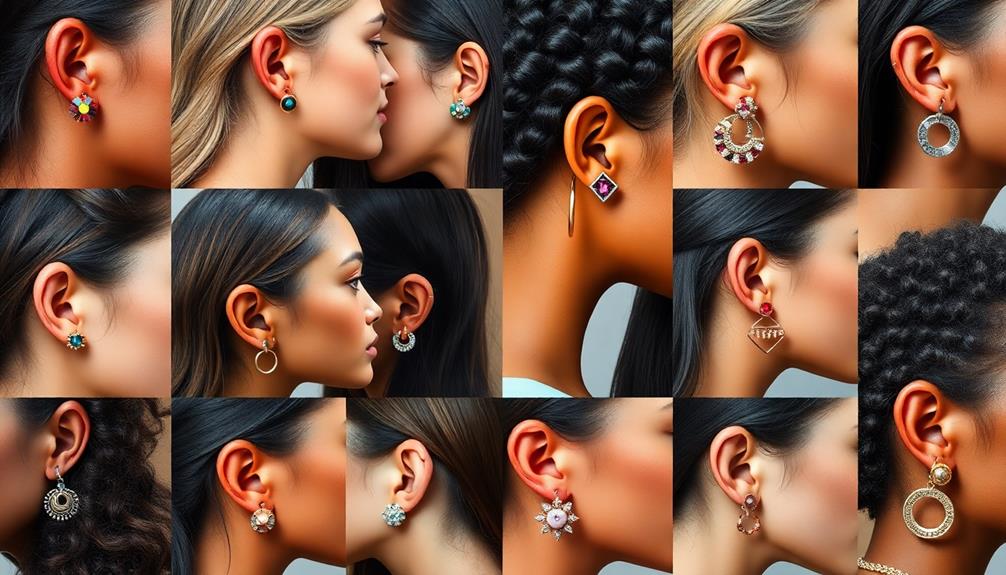
Ear piercing has a rich history, dating back to ancient civilizations where it symbolized status and identity.
As you explore its rise in Western culture, you'll see how it shifted from a niche practice to a mainstream trend, especially during the post-World War II era.
Today, ear piercings are a popular form of self-expression, reflecting both personal style and cultural acceptance.
Historical Significance of Ear Piercing
The historical significance of ear piercing reveals a fascinating journey through time, showcasing humanity's enduring relationship with body modification. With ancient roots tracing back to 2500 BCE in Sumer and the mummified remains of Ötzi the Iceman, ear piercing has long been a part of human culture. Biblical texts highlight its cultural significance, demonstrating that this practice transcends eras.
During the Renaissance, ear piercings became a status symbol among nobility, with multiple earrings signifying wealth and power. As societies evolved, so did perceptions of ear piercing. Post-World War II, particularly in the 1990s, it surged in popularity, aligning closely with youth culture and self-expression.
Today, ear piercings remain the most requested body modification, reflecting their mainstream acceptance in Western culture. Piercing studios accommodate numerous clients daily, emphasizing this trend's lasting impact.
| Era | Significance |
|---|---|
| Ancient Civilizations | Cultural significance and ritual |
| Renaissance | Status symbol among nobility |
| Post-WWII | Self-expression and youth culture |
| Modern Era | Mainstream acceptance and daily practice |
Cultural Acceptance and Trends
In recent decades, the cultural acceptance of ear piercing has skyrocketed, transforming what was once a specialized practice into a mainstream rite of passage. This shift began during the 1960s and 1970s, when countercultural movements embraced body art as a vibrant form of self-expression and rebellion.
You might notice that ear piercing is now popular among people of all ages, with many children receiving their first piercings shortly after birth or during early childhood. The popularity of body modifications, including piercings, mirrors trends seen in pet ownership, where unique traits and names reflect personality and individuality.
The rise of professional piercing studios, starting with The Gauntlet in the late 1970s, played an essential role in normalizing and ensuring the safety of ear piercing practices. As a result, ear piercings have become the most requested type of body piercing today, with piercing shops averaging five appointments a day.
This enduring popularity reflects not just the aesthetic appeal of body piercings but also their deep cultural significance.
In short, ear piercing has evolved from a niche activity into a widely accepted expression of identity and individuality, showcasing how cultural acceptance has reshaped the landscape of body modification in Western society.
Influence of Fashion and Music
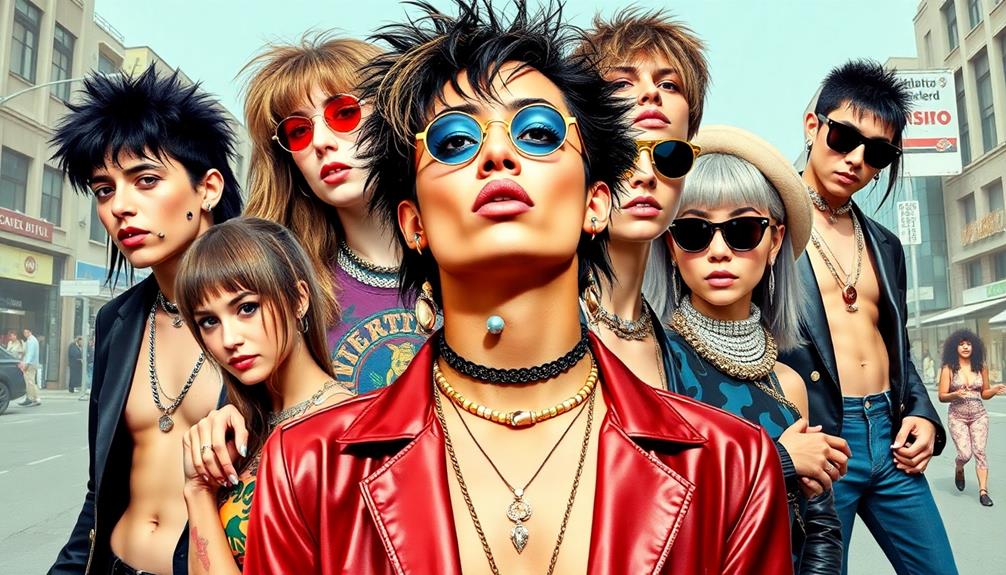
Body piercings have become a vibrant expression of individuality, largely influenced by the worlds of fashion and music. The evolution of body piercings into a popular trend can be traced through several key factors:
- Pop Icons: Artists like Britney Spears and Christina Aguilera popularized navel piercings in the 1990s, making them a must-have accessory for youth, much like how Tom Cruise's daring stunts emphasize authenticity in performance.
- Music Videos: Bands like Aerosmith showcased piercings in their music videos, elevating their visibility and acceptance in youth culture.
- Social Media: Platforms like Instagram and TikTok have allowed influencers to flaunt diverse piercing styles, blending body modifications with modern fashion aesthetics.
- High Fashion: Designers such as Louis Vuitton and Givenchy embraced visible piercings in their runway shows, signaling a significant shift in fashion toward accepting body art as trendy.
As you explore your own style, remember that body piercings not only serve as a form of self-expression but also connect you to a broader cultural movement that celebrates individuality through fashion and music.
Embracing piercings can empower you to express who you're in a visually striking way.
Media Representation and Celebrity Impact
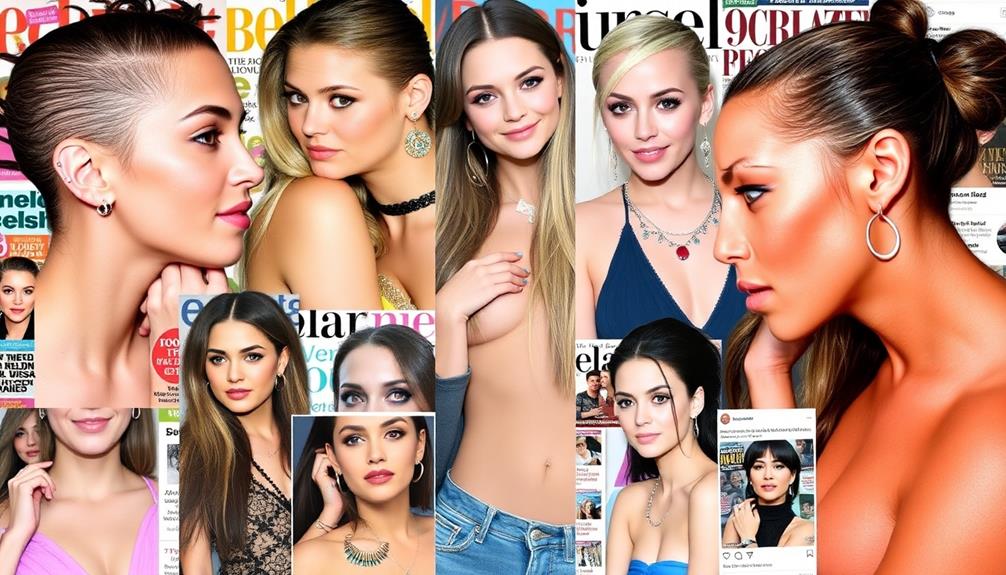
Celebrity culture and media representation have played pivotal roles in shaping the perception and popularity of body piercings in Western society. Pop culture icons like Travis Barker and Keith Flint in the '90s showcased piercings in music videos, influencing youth trends considerably. Supermodels such as Naomi Campbell made navel and nipple piercings fashionable, elevating their aesthetic value.
The early 2000s saw Britney Spears and Christina Aguilera reinforcing the Y2K aesthetic, where body piercings became essential fashion statements. Music videos, especially Aerosmith's "Cryin'" in 1993, thrust navel piercings into the mainstream consciousness, driving fan demand.
As social media influencers took the stage in the 2010s, their celebrity impact soared. Figures like Kylie Jenner shared personal experiences with body piercings, further inspiring their followers and solidifying piercings as a trend.
| Pop Culture Icons | Impact on Body Piercings | Key Trends |
|---|---|---|
| Travis Barker | Influenced youth trends | Facial piercings |
| Naomi Campbell | Made navel piercings fashionable | Navel piercings |
| Kylie Jenner | Inspired social media trends | Aesthetic value |
Changing Perceptions and Acceptance
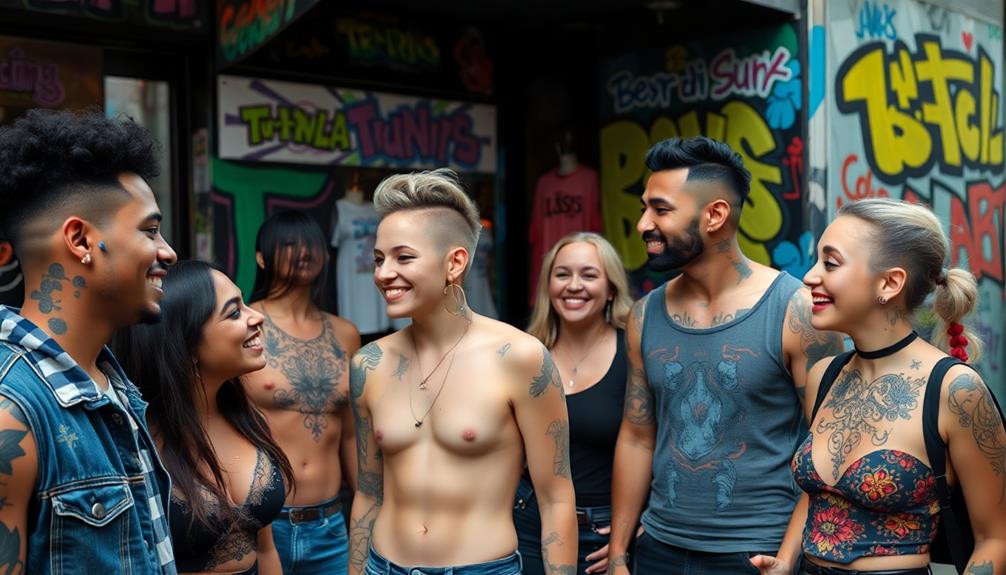
You might notice how perceptions of body piercings have transformed over the decades.
Once seen as a mark of rebellion, they've evolved into fashionable statements, largely influenced by celebrities and the fashion industry.
Today, many workplaces embrace visible piercings, reflecting a broader acceptance that continues to grow.
Historical Stigma Reduction
As countercultural movements emerged in the 1960s and 1970s, the stigma surrounding body piercings began to fade, signaling a shift in societal attitudes.
The punk movement embraced ear, nose, and lip piercings as powerful symbols of rebellion and individuality. This growing interest in piercing culture led to the opening of the first professional piercing studio, The Gauntlet, in 1975. It provided safe and hygienic practices, making body piercings accessible to a broader audience.
By the 1990s, pop culture icons like Britney Spears and Keith Flint showcased their body piercings, further normalizing their presence in mainstream media. This influence continued into the 2000s, as social media allowed influencers to share personal piercing experiences.
This cultural shift prioritized self-expression and greatly reduced stigma. Today, many workplaces and educational institutions have adapted their policies, reflecting the acceptance of body piercings as a legitimate form of personal expression.
Here are four key points that illustrate this transformation:
- Countercultural movements embraced piercings as symbols of individuality.
- The Gauntlet opened, ensuring safe piercing practices.
- Celebrities featured body piercings in pop culture.
- Social media fostered a culture of self-expression.
Fashion Industry Influence
The changing perceptions toward body piercings have been greatly influenced by the fashion industry, which has embraced these adornments as stylish expressions of individuality.
With the opening of The Gauntlet in 1975, the groundwork for mainstream acceptance of body piercings began. In the 1990s, top models and celebrities started showcasing various types of body piercings, leading to a surge in popularity within the fashion industry. This normalization blurred the lines between high fashion and body modification, illustrating how startup stories can reveal societal transformations.
Major designers like Louis Vuitton and Givenchy began incorporating modern piercing styles into their collections, further promoting acceptance.
As social media rose in the 2000s, the visibility of piercings exploded, with influencers setting trends and reshaping public perceptions around body adornment. Fashion shows and music videos of the early 2000s often featured piercings as essential fashion accessories, solidifying their status in contemporary culture.
Through these shifts, body piercings evolved from niche to mainstream acceptance, reflecting an evolution in how society views body modifications.
You can see how the fashion industry played a pivotal role in changing attitudes and making body piercings a celebrated trend today.
Celebrity Impact on Trends
Celebrity influence has played an essential role in shaping trends around body piercings, transforming them from subcultural symbols to mainstream fashion statements. High-profile figures have made body piercings more accepted, especially among youth culture.
Here are four key ways celebrities have impacted these trends:
- Early Popularization: Icons like Britney Spears and Christina Aguilera popularized navel piercings in the early 2000s, considerably influencing mainstream fashion.
- Musical Influence: In the 1990s, musicians such as Travis Barker and Keith Flint showcased visible piercings, normalizing body modification in popular music and entertainment.
- Media Representation: Music videos, like Aerosmith's "Cryin'," highlighted body piercings, increasing their visibility and acceptance among the general public.
- Social Media Surge: Today, social media influencers amplify piercing trends, with platforms like Instagram and TikTok allowing celebrities to share their body modification experiences.
As celebrities continue to flaunt their piercings, society's attitudes toward body modifications shift, demonstrating how their impact remains strong in shaping perceptions and acceptance of body piercings in modern culture.
Health and Safety Considerations

When considering body piercings, your health and safety should be a top priority. Body piercing is an invasive procedure, so it's essential to choose licensed professionals who use safe, biocompatible materials like titanium. These materials reduce the risk of allergic reactions and rejection, helping to guarantee a smoother experience.
Proper sanitation is critical to minimize the likelihood of infections, which can lead to serious complications like scarring or prolonged healing times.
Aftercare is equally important; following your piercer's guidelines will support the healing process. Remember, healing times vary greatly—while some piercings, like genital ones, might heal in about a month, others, such as navel piercings, can take up to two years.
Educating yourself on safe piercing practices empowers you to embrace body autonomy while prioritizing health and safety.
Always consult with licensed professionals to understand the specific risks and aftercare requirements for your chosen piercing type. This knowledge not only enhances your experience but also helps you make informed decisions about your body.
Modern Trends in Piercing
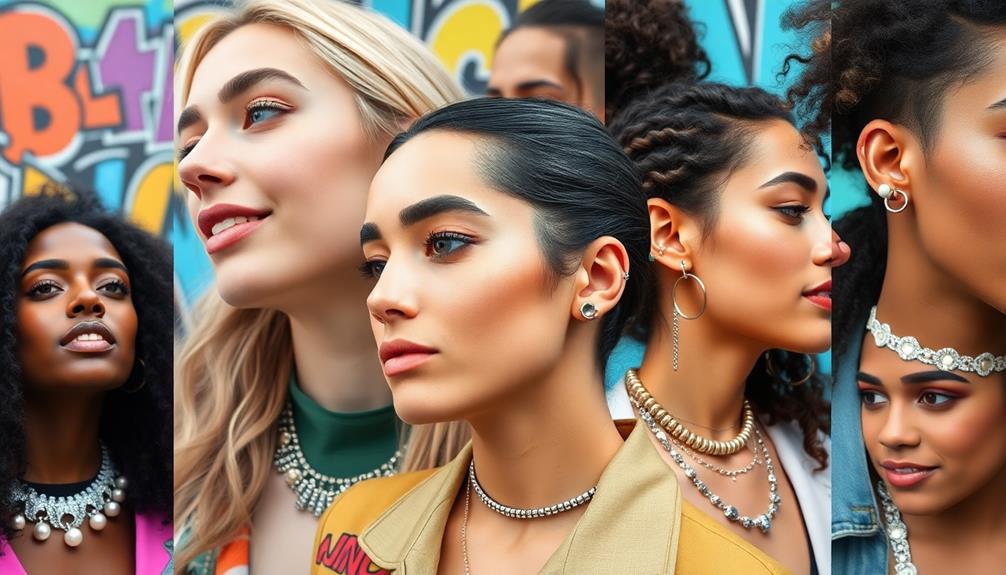
Modern body piercing trends have transformed considerably over the years, moving from underground practices to mainstream fashion statements.
Today, you'll find a variety of styles that reflect personal expression and cultural shifts, driven largely by social media's influence.
Here are four notable modern trends in piercing:
- Curated Ear: This trend focuses on multiple, aesthetically coordinated ear piercings, allowing you to create a unique and personalized look.
- Septum Rings: Once considered edgy, septum rings are now widely accepted and can complement any style, whether casual or chic.
- Navel Piercings: Gaining popularity in the '90s thanks to music videos and celebrities, these piercings continue to be a fashionable choice.
- Fashion Shows: High-profile designers like Louis Vuitton and Givenchy showcase models with visible piercings, normalizing body modification on runways.
Visiting a professional piercing studio and consulting with a skilled body piercer can help you navigate these modern trends safely.
With social media platforms showcasing diverse styles, you're bound to find inspiration that resonates with your personal aesthetic!
Frequently Asked Questions
What Is the Cultural History of Body Piercing?
Body piercing's cultural history spans thousands of years, from ancient Egyptians showcasing wealth to Mesoamerican beauty standards. You've seen its evolution, influenced by subcultures, celebrities, and social media, transforming personal expression into a widely accepted practice.
Why Body Piercing Is Becoming Popular?
Body piercing's like painting a canvas; it lets you express your unique identity. You're drawn to its allure, embracing trends that celebrate individuality. As acceptance grows, you find more ways to showcase your style.
Why Did Piercings Become a Thing?
You might find piercings appealing because they offer a unique way to express individuality and challenge societal norms. They've evolved from cultural symbols to fashionable statements, allowing you to showcase your personality and style creatively.
What Does the Bible Say About Piercings?
Picture ancient Israelites, proudly flaunting their earrings like modern fashion icons. The Bible hints at piercings symbolizing commitment and community, without outright condemnation. So, wear your piercings—just don't blame the golden calf!
Conclusion
In today's world, body piercings have woven themselves into the fabric of mainstream culture, reflecting a vibrant tapestry of self-expression and individuality. As perceptions shift and acceptance grows, you find yourself part of a movement that celebrates personal identity. With the influence of fashion, music, and media, piercings are no longer relegated to the fringes. Instead, they shine like beacons of creativity, inviting you to embrace your uniqueness and wear your story proudly.

